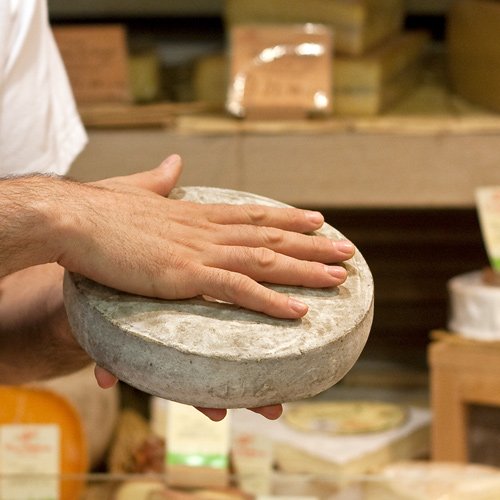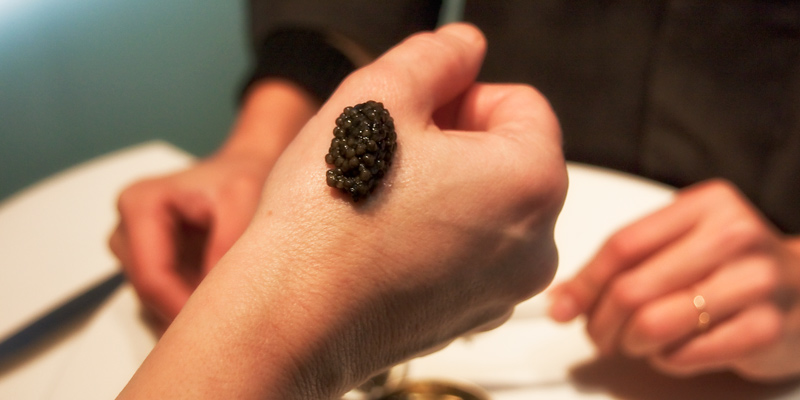Famous French Food – A Culinary Journey Through Tradition
The best French food comes to Paris from all corners of France and can be found in thousands of restaurants, food shops, street markets, and bistros. One of our greatest joys when in Paris is to discover and enjoy the bounty of French food.
Food and wine are important parts of French culture and life; les Français treat them seriously and with joy. It's hard for us who come from other cultures to truly appreciate how much food is woven into the very fabric of French life. As you can probably tell, we love the foods of France. So, join in as we share more fascinating information about the special foods you will encounter when you're in the City of Food.
![]()
Our Top-Rated Food & Wine Experiences
1. Cheese and Wine Tasting in a Private Paris Cheese Cellar… Learn from a Master Affineur
2. A Taste of Montmartre: Food & Wine Tour… Tour the best food shops in the village on the hill
3. Wine Tasting in the Heart of Paris… A sommelier leads a fun and informative wine tasting
4. Dinner at Madame Brasserie on the Eiffel Tower… The very best dining views in Paris
French Food Standards

Because of its importance to the country, all of the best food produced in France is subject to stringent regulations to ensure the quality of the food, its origin, and that consumers know exactly what they are buying.
Most of these food standards are embodied in the AOC system, or Appellation d'Origine Contrôlée (controlled designation of origin). Early examples of controlled designation systems date back to the 15th century.
Champagne and Roquefort are two familiar examples. For a cheese to be labelled "Roquefort", for instance, it must be produced in that designated region of France, made with only certain types of milk, from certain cows, in a certain way and aged in certain caves. And so it goes with many types of food in France.
![]()
Discover What's On When You're Here...
• January... |
• February... |
• March... |
• April... |
• May... |
• June... |
• July... |
• August... |
• September... |
• October... |
• November... |
• December... |
Discover What's On When You're Here
• January...
|
• February... |
• March... |
|---|---|---|
• April... |
• May... |
• June... |
• July... |
• August... |
• September... |
• October... |
• November... |
• December... |
French Cheese
Visit a Paris fromagerie and you'll be astounded by the choice in cheeses from different animals, from different regions and made in a variety of ways. Come long with us and get a (virtual) chance to sample some of the 1000 types of cheese made in France today.
Baguettes
You probably know that the French adore crusty bread, but did you know that the baguette was created to make a bread with more crust?
It's simple geometry — the longer a shape is the greater the ratio of surface area to volume. In the case of the baguette, that means more crust! One of the first things we do every time we arrive in Paris is dash out to the nearest boulangerie and bring back a couple of freshly-baked baguettes.
Cooking Classes in Paris
The best way to learn how to use the famous foods of France is by joining a cooking class while you're in Paris. It's also one of most fun ways of getting into the food culture of France.
A half day spent at a cooking class will be both memorable and filled with cooking experiences. You'll come away knowing to make classic French dishes at home.
![]()
Romantic Dinner Cruises In Paris
|
VIP Dinner Cruise with Bateaux Parisiens |
Dinner Cruise by Maxim's of Paris |
|
VIP Dinner Cruise with Bateaux Parisiens |
Croissants
Marie Antoinette may have brought the croissant from her native Austria, but it was the French bakers who made it famous. Parisian croissants are amazingly light and flakey thanks to a skillful layering of butter and dough, butter and dough, butter and dough.
Maybe Marie should have said, "Let them eat croissants."
Caviar
Smoky, silky and delicious, one of the most famous French specialty foods has to be caviar. We never really ate caviar until we tasted it in Paris. It's been one of our fave food finds in France! With dwindling supplies of sturgeon in the wild, the French have been growing their own caviar for a hundred years by farming sturgeon in the Dordogne.
We'll tell you where to find the best caviar in Paris. And, yes, the photo shows the best way to taste it!
![]()
Delectable Food Tours in Paris
|
Discover the Food & Wine of the Marais |
Cheese & Wine Tasting in a Paris Cellar |
|
Cheese & Wine Tasting in a Paris Cellar |
French Butter
Who are the biggest butter eaters in the world? It's not really a tough question — the French, of course. And it's no wonder — the butter they make and eat is the best anywhere in the world. Butter even has two AOCs.
It won't come as much of a surprise to find out that one of the reasons French butter tastes better than ours is because it has an even higher butter fat content. Go figure.
Food & Wine Walking Tours in Paris
Know how to learn more about French wine and food and get a little exercise as well at the same time? Join one of our recommended food and wine walking tours in Paris. It's what we've done on numerous occasions.
What we love is that these activities let you get behind the scenes of Paris food. Learn the secrets of French chocolate making, visit a boulangerie. You'll find these and more in our complete guide to the the best food-based walking tours.
Oysters
Parisians are crazy about oysters, and so are we! Did you know that 90% of the vast French oyster harvest from the Atlantic coast is consumed in France and about half of the 150,000 metric tonne annual crop is eaten between Christmas and New Year? (Probably because we're there at that time.)
What's more, with modern oyster raising techniques the tasty little mollusks can pretty much be eaten year-round, although we still prefer our September to April oyster feasts.
![]()
Find Hotel Deals for Your Dates in Paris
Check the complete list of Paris hotels to find current sale prices on rooms in every arrondissement. Save 10%, 20%… or even more! |
Paris Hotel Deals |
Find Hotel Deals for Your Dates in Paris
Save on hotels in every arrondissement of Paris – the Latin Quarter, Saint Germain, the Right Bank, the Marais, near the Eiffel Tower. Save 10%, 20%… or even more! |
Black Truffles
Diamant noir, black diamond, Texas tea (we're kidding about that one) is the name given to the precious black truffle — the most prized of all French foods.
Come along with us on a visit to a trufficulteur in Provence to learn how truffles are grown and harvested. We've also discovered the best places to find truffles in Paris. (And it doesn't require a truffle dog!)
French Beef, Poultry & Seafood
The French are very particular about their meats and so, of course, they strive the have the very best — including hearty French beef, prized Bresse chicken and fresh line-caught fish.
You can learn a lot about these meats and other fresh products by visiting a French market. That's what we did and we learned about the amazing history of these staples of French food.
The AOC System – Protecting A Legacy
As we said, France takes its food seriously, and the AOC system (Appellation d'Origine Contrôlée) is a testament to this dedication. Created in 1935, AOC is a certification that guarantees the origin, quality, and production methods of specific foods and drink. It applies to a wide range of products, including wine, cheese, butter, and even lavender, ensuring that every bite or sip reflects centuries of tradition and expertise.
The AOC label is more than just a stamp of authenticity; it's a safeguard for France's culinary heritage. To earn the designation, products must meet stringent standards, from the geographical region where they are produced to the specific methods used. For instance, the creamy Camembert de Normandie and the robust Roquefort must adhere to traditional recipes and processes to carry the AOC distinction.
For consumers, the AOC label is a promise of quality, offering reassurance that what they're enjoying is not only genuine but also steeped in history. It protects local producers from imitation and helps maintain the integrity of France's culinary traditions.
When exploring famous French food, looking for the AOC label is a surefire way to experience the best of what this gastronomic powerhouse has to offer. Bon appétit !
Paris Planning Guides
 VIP to Champagne
VIP to Champagne |
 10 Food Experiences
10 Food Experiences |
 Montmartre Guide
Montmartre Guide |
 Glorious Dinner Cruises
Glorious Dinner Cruises |






















